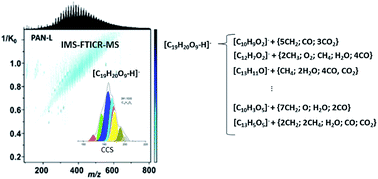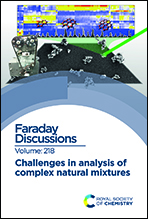Understanding the structural complexity of dissolved organic matter: isomeric diversity†
Abstract
In the present work, the advantages of ESI-TIMS-FT-ICR MS to address the isomeric content of dissolved organic matter are studied. While the MS spectra allowed the observation of a high number of peaks (e.g., PAN-L: 5004 and PAN-S: 4660), over 4× features were observed in the IMS-MS domain (e.g., PAN-L: 22 015 and PAN-S: 20 954). Assuming a total general formula of CxHyN0–3O0–19S0–1, 3066 and 2830 chemical assignments were made in a single infusion experiment for PAN-L and PAN-S, respectively. Most of the identified chemical compounds (∼80%) corresponded to highly conjugated oxygen compounds (O1–O20). ESI-TIMS-FT-ICR MS provided a lower estimate of the number of structural and conformational isomers (e.g., an average of 6–10 isomers per chemical formula were observed). Moreover, ESI-q-FT-ICR MS/MS at the level of nominal mass (i.e., 1 Da isolation) allowed for further estimation of the number of isomers based on unique fragmentation patterns and core fragments; the later suggested that multiple structural isomers could have very closely related CCS. These studies demonstrate the need for ultrahigh resolution TIMS mobility scan functions (e.g., R = 200–500) in addition to tandem MS/MS isolation strategies.

- This article is part of the themed collection: Challenges in analysis of complex natural mixtures


 Please wait while we load your content...
Please wait while we load your content...